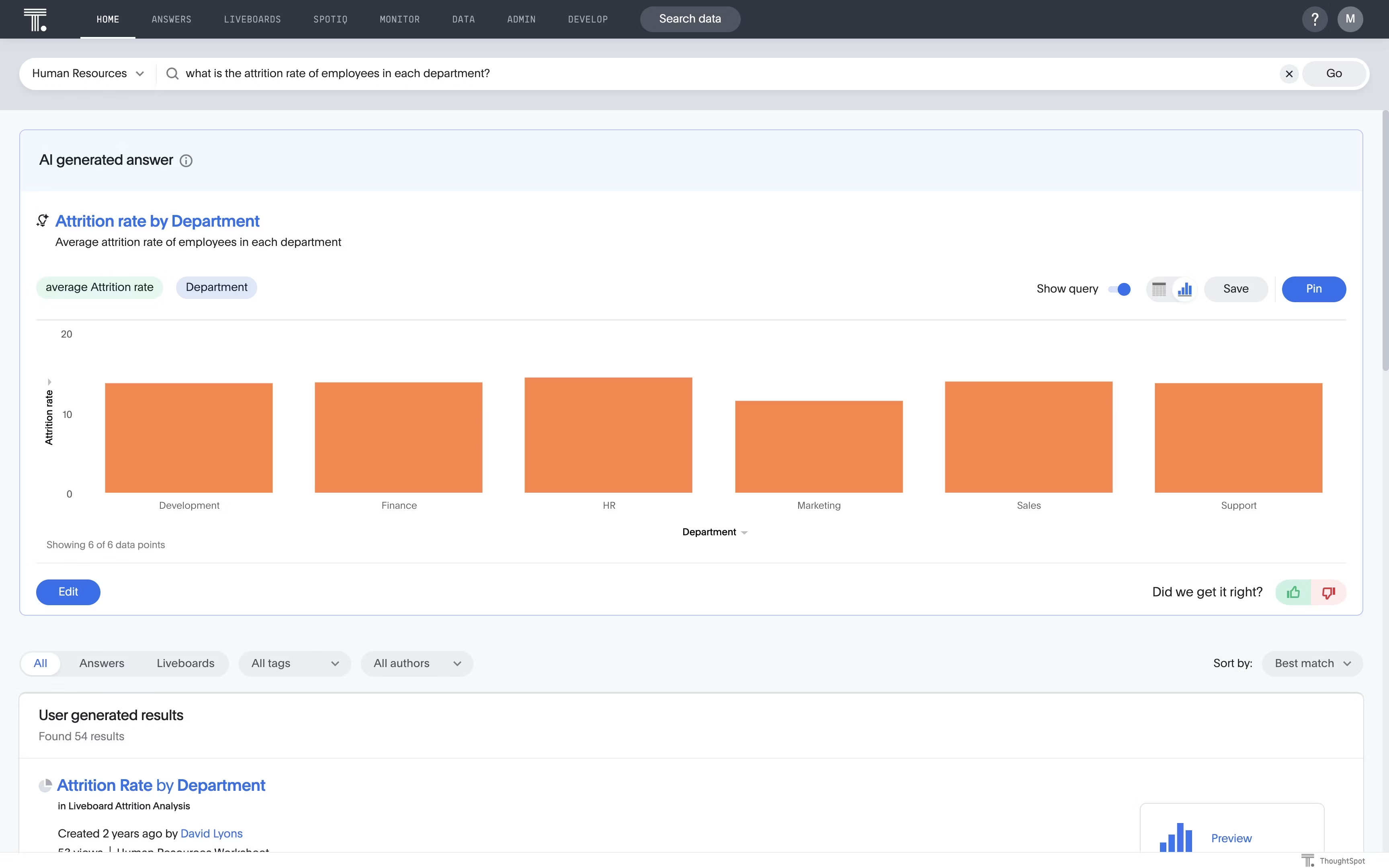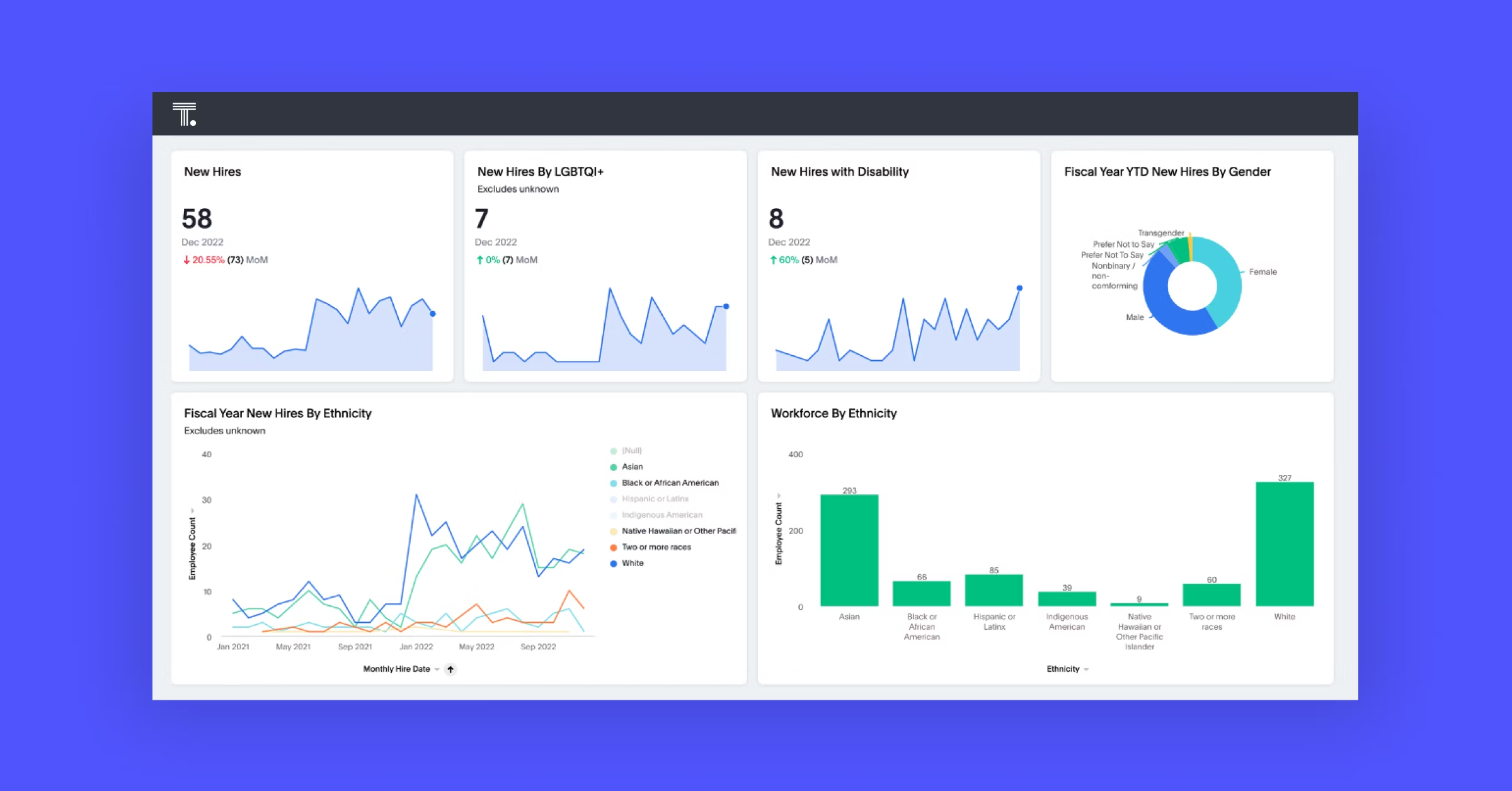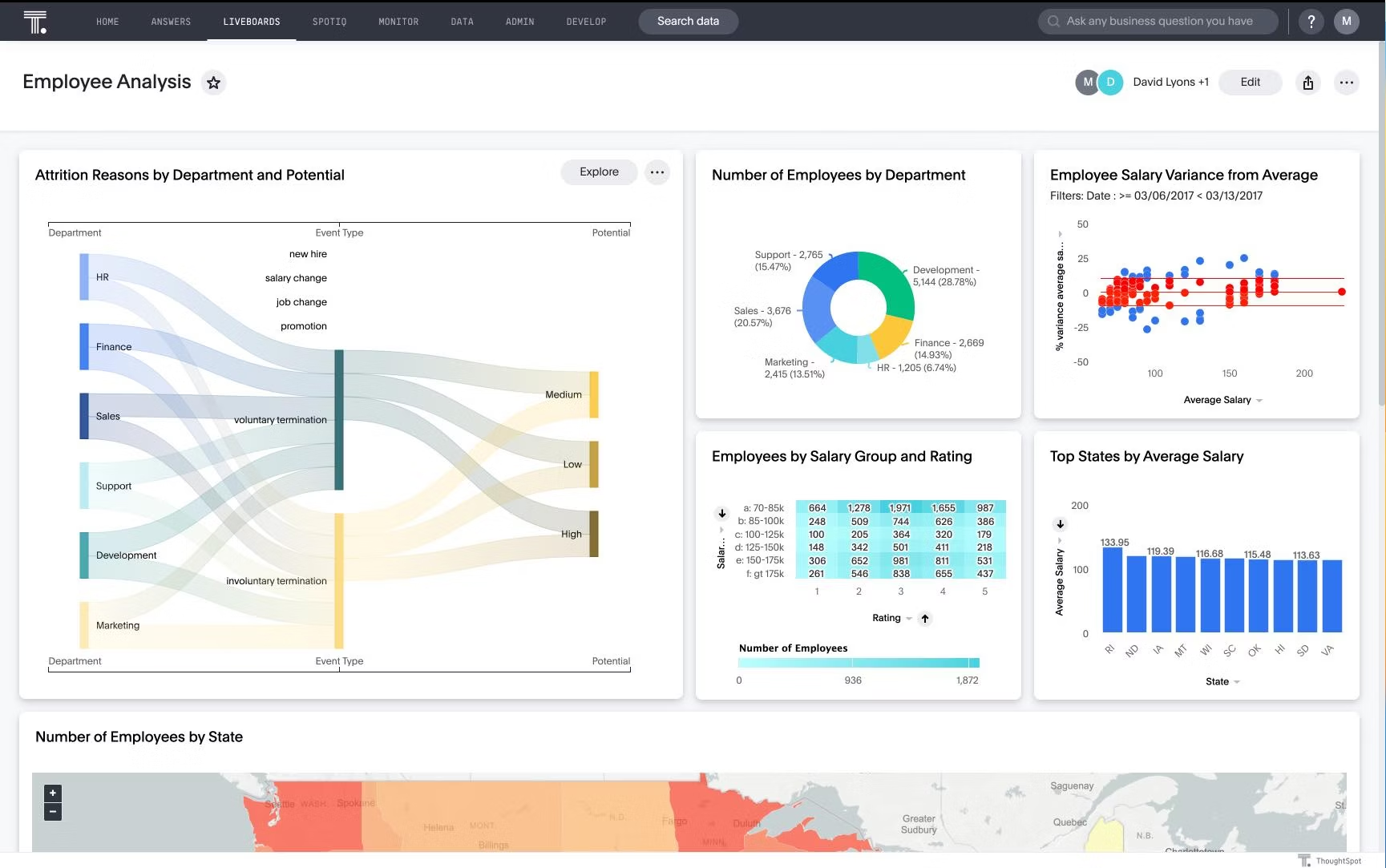At the heart of every business, and what truly sets it up for success, are its people. Talent is the great differentiator, today more than ever. Sustained success for any organization rests squarely on the shoulders of its team, which is why the HR (Human Resources) function of any business is more crucial than ever.
The most successful of these professionals realize the requirements–and opportunity–for their profession has changed. To make the most of today’s talent landscape, it’s imperative people and HR professionals use data to track and measure their efforts. Equipped with these people analytics and interactive HR dashboards, they can drive better outcomes across people management, talent acquisition, employee retention and development. With that being said, staying on top of HR metrics and KPIs offers a ton of insight into where your HR division or team may be falling short or excelling – data that can then be used to make concrete changes that help talent be as effective as possible.

But what exactly should you be tracking if you want to create an environment where talent can contribute as much as possible to your company’s success? Our HR organization has designed and built several People-related Liveboards in ThoughtSpot over the last two years. By doing this, we have put the data and key insights in the hands of business users, regardless of their technical savvy, to help drive meaningful action. If you’re looking for a starting point, we have identified the 12 major HR metrics & KPIs that you can track using HR analytics software to maximize the impact of your team in the most effective, efficient manner.
1. Employee turnover rate
Employee turnover rate measures the percentage of employees who leave the organization over a specific period. High turnover can indicate underlying issues, such as poor job satisfaction, lack of growth opportunities, or ineffective management. (One easy way to boost employee satisfaction: give your business people access to data with self service analytics, as research from Harvard points out).

By tracking this HR metric, organizations can identify trends, analyze the reasons behind turnover, and implement strategies to improve employee retention.
2. Time to hire
Time to hire measures the average time it takes to fill a job vacancy once the position has been posted. Tracking this metric helps organizations assess the efficiency of their recruitment and interview processes. A lengthy hiring process can lead to losing qualified candidates to competitors or increased workload on existing employees. Conversely, abridged time to hire may indicate organizations aren’t thoroughly vetting candidates, which can lead to talent gaps and decreased performance. By optimizing time to hire, organizations can attract top talent and minimize productivity gaps.

3. Cost per hire
Cost per hire evaluates the average expenses incurred as you recruit and hire new talent. This spans advertising, interviewing, and onboarding costs. By closely monitoring this metric, organizations can understand the cost-effectiveness of their hiring procedures and identify opportunities for optimization. By reducing the cost per hire, organizations can allocate resources more efficiently while maintaining quality recruitment practices.

4. Employee satisfaction
Employee satisfaction examines the contentment levels of employees within the organization. It’s no secret that happier, more satisfied employees drive better business outcomes. People and HR professionals who monitor this metric, whether through surveys, feedback sessions, or engagement tools, can help boost their overall business’s success by helping to identify areas of improvement, addressing employee concerns quickly, and fostering a positive work culture.
5. Employee productivity
Employee productivity measures the output and efficiency of employees in accomplishing their tasks and responsibilities. It may include various factors such as task completion rates, quality of work, the amount of working and idle time, and adherence to deadlines. Depending on your organization’s goals and the scope of individual employees, how you calculate this metric will vary. HR teams, in partnership with management, have a significant role to play in making sure employees have the tools and environment they need to do their work as efficiently and effectively as possible. HR professionals should evaluate this metric on an individual basis, by team, and at the department level to get a thorough understanding of the various components that enable–or detract–from employee productivity. By monitoring productivity, organizations can identify performance gaps, provide necessary support and resources, and implement strategies to enhance overall productivity.
6. Training and development ROI
Talent today doesn’t want to rest on its laurels; they want to continue to learn and grow. Training and Development ROI is a way for people and HR professionals to measure the return on investment for training initiatives. Depending on your company, exactly how you calculate ROI will vary. At its core, however, it evaluates the effectiveness of training programs in terms of improved employee skills, knowledge, and performance, such as how data literacy programs can help create a culture of data-driven decision making. Forward thinking organizations often go further, and correlate this with employee satisfaction. By tracking this metric, organizations can assess the value and impact of their training investments to determine the best, most effective programs to implement.
7. Absenteeism rate
Absenteeism rate calculates the frequency and duration of employee absences from work. Understanding how often employees are working directly impacts many of the other metrics discussed so far. High absenteeism can be indicative of underlying issues such as low employee morale, health concerns, or dissatisfaction. Low absenteeism is usually a positive signal, but when taken to the extreme, may point to organizations not providing enough cover for employees to take time off and recharge. By looking at this HR KPI on a regular basis, people and HR teams can identify patterns, implement policies to address absenteeism, and promote a healthy work environment.

8. Diversity, equity, and inclusion
Diversity, equity, and inclusion metrics assess the organization's efforts in promoting a workforce that attracts, retains, and empowers employees from all walks of life to contribute as much as possible to the organization. These HR metrics can include the representation of underrepresented groups, diversity in leadership positions, salary and pay equity, or employee feedback on inclusivity. The amount of research and data demonstrating the improved business performance of diverse, inclusive teams is overwhelming. By tracking diversity and inclusion metrics, organizations can identify areas for improvement, enhance diversity initiatives, and foster a more inclusive workplace culture that ultimately creates a stronger, more resilient business.

For example, we have created an internal Diversity, Equity, and Inclusion Liveboard to monitor key metrics aligned with our DEI programs and initiatives that all employees at ThoughtSpot can access. This allows us to build trust with transparency by tracking and improving key diversity and inclusion metrics within our organization. This Liveboard made such a significant impact at our organization that we have created to allow other organizations to quickly leverage the power of ThoughtSpot.
9. Employee engagement
Employee engagement measures the emotional connection and commitment employees have towards their work, team, and the overall organization. Engaged employees are more likely to be motivated, productive, and loyal. Depending on your company, how you evaluate employee engagement will vary, and may include a mix of quantitative and qualitative methods such as surveys, feedback mechanisms, or pulse-checks. With this view, organizations can better gauge the level of engagement, identify drivers and barriers, and implement strategies to enhance employee satisfaction and commitment.
10. Performance rating
Performance rating metrics assess individual and team performance against predefined goals and expectations. Like other metrics here, how you calculate this will shift depending on your business or the scope of an individual’s role. These metrics can include performance appraisal scores, achievement of targets, or feedback from managers and peers.Once you determine how to effectively measure performance rating, you can identify top performers, provide targeted feedback and development opportunities, and align performance with business objectives.
11. HR-to-employee ratio
To ensure you have the right coverage for employees, it’s important to track your HR-to-employee ratio. This HR KPI measures the number of HR professionals relative to the size of the workforce. This HR metric helps organizations evaluate the HR department's capacity to support and serve employees effectively. By tracking this ratio, organizations can ensure an adequate HR team size to manage HR processes, provide support, and maintain compliance with legal and regulatory requirements.

12. Revenue per employee
At the end of the day, businesses are about creating revenue, and that rests on the shoulders of every member of the team. Revenue per employee is an effective metric to understand the revenue generated per employee, and helps organizations understand the productivity and contribution of employees to the organization's financial performance. By tracking revenue per employee, organizations can assess efficiency, identify areas for improvement, and optimize resource allocation to maximize revenue generation.

The future of human resource (HR) dashboards
Having all of this information in a single dashboard is a good first step for organizations, but doesn’t do enough to provide insights to changes as they happen. Instead of relying on static dashboards that surface data that may be days or weeks old, companies like Schneider Electric are turning to Liveboards in ThoughtSpot to empower their people and HR teams with a real time, always up to date view of critical HR metrics and KPIs.

Get a data-driven view of talent as dynamic as your team is with ThoughtSpot
What’s more, because ThoughtSpot provides an intuitive, search driven experience for business analytics use cases, people teams can continue to drill down into their data, ask questions in natural language, and get insights instantly—all without having to ask data teams to build a new dashboard.
Make more informed decisions
Tracking the right HR metrics and KPIs can give you an overall view of how your human resources department is performing. You can use HR data to build KPI reports, find trends, and make better decisions for your company - both now and in the future. With all these 12 metrics and KPIs in mind, you can capture multi-dimensional insights that give you a comprehensive understanding of your talent pool.
To ensure that your team of performance analysts are able to easily access and track these metrics quickly and efficiently with up-to-date results, try using ThoughtSpot’s powerful AI analytics. This way, everybody wins—report developers get fast answers managing the data, HR teams get reliable insight into employee performance, while decision makers have a better overview to make informed decisions on their workforce strategically. Put all this together to maximize and sustain high productivity in your Human Resources department.
Book a demo today so you can start tracking key success factors for your organization!









